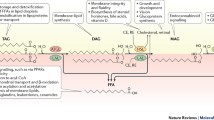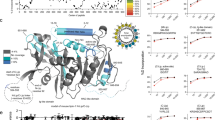Summary
Translocation of lipids inside mammalian cells is considered to be facilitated by a number of low-molecular weight lipid binding proteins. An overview of these proteins is given, with particular reference to the heart. Three distinct phospholipid transfer proteins specifically stimulate the net transfer of individual phospholipid classes between membrane structures. In rat cardiac muscle their content is 15–140 pmol/g ww. Fatty acid-binding proteins (FABP) are abundantly present in tissues actively involved in the uptake or utilization of long-chain fatty acids, such as intestine, liver and heart. The four distinct FABP types now identified show a complex tissue distribution with some tissues containing more than one type. Heart (H-) FABP comprises about 5% of the cytosolic protein mass; its content in rat heart is 100 nmol/g ww. Immunochemical evidence has been obtained for the presence of H-FABP in several other tissues, including red skeletal muscle, mammary gland and kidney. Beside long-chain fatty acids FABP binds with similar affinity also fatty acyl-CoA and acyl-L-carnitines. In heart the latter compound may be the primary ligand, since normoxic acyl-L-carnitine levels are several fold higher than those of fatty acids. In addition, H-FABP was found to modulate cardiac energy production by controlling the transfer of acyl-L-carnitine to the mitochondrial β-oxidative system. H-FABP may also protect the heart against the toxic effects of high intracellular levels of fatty acid intermediates that arise during ischemia.
Similar content being viewed by others
References
Stremmel W: Transmembrane transport of fatty acids into cardiomyocytes. Mol Cell Biochem 88: 23–29, 1989
Sleight RG: Intracellular lipid transport in eukaryotes. Ann Rev Physiol 49: 193–208, 1987
Wirtz KWA: Phospholipid transfer proteins. In: PC Jost and OG Griffith (eds) Lipid-protein interactions, volume 1. Wiley Interscience, New York, 1982, pp 151–231
Zilversmit DB: Lipid transfer proteins. J Lipid Res 25: 1563–1569, 1984
Teerlink T, Van der Krift TP, Post M, Wirtz KWA: Tissue distribution and subcellular localization of phosphatidylcholine transfer protein in rats as determined by radioimmunoassay. Biochim Biophys Acta 713: 61–67, 1982
Van Amerongen A, Teerlink T, Van Heusden GPI, Wirtz KWA: The non-specific lipid transfer protein (sterol carrier protein 2) from rat and bovine liver. Chem Phys Lipids 38: 195–204, 1985
Glatz JFC, Veerkamp JH: Intracellular fatty acid-binding proteins. Review. Int J Biochem 17: 13–22, 1985
Bass NM: The cellular fatty acid-binding proteins: Aspects of structure, regulation and function. Int Review Cytol 111: 143–184, 1988
Sweetser DA, Heuckeroth RO, Gordon JI: The metabolic significance of mammalian fatty acid-binding proteins: abundant proteins in search of a function. Ann Rev Nutr 7: 337–359, 1987
Glatz JFC, Van der Vusse GJ, Veerkamp JH: Fatty acidbinding proteins and their physiological significance. News Physiol Sci 3: 41–43, 1988
Bass NM, Manning JA: Tissue expression of three structurally different fatty acid-binding proteins from rat heart muscle, liver and intestine. Biochem Biophys Res Common 137: 929–935, 1986
Crisman TS, Claffey KP, Saouaf R, Hanspal J, Brecher P: Measurement of rat heart fatty acid-binding protein by ELISA. Tissue distribution, development changes and subcellular distribution. J Mol Cell Cardiol 19: 423–431, 1987
Jones PD, Carne A, Bass NM, Grigor MR: Isolation and characterization of fatty acid-binding proteins from mammary tissue of lactating rats. Biochem J 251: 919–925, 1988
Heukeroth RO, Birkenmeier EH, Levin MS, Gordon JI: Analysis of the tissue-specific expression, developmental regulation, and linkage relationships of a rodent gene encoding heart fatty acid-binding protein. J Biol Chem 262: 9709–9717, 1987
Fournier NC, Rahim M: Control of energy production in the heart: A new function for fatty acid-binding protein. Biochemistry 24: 2387–2396, 1985
Böhmer FD, Kraft R, Otto A, Wernstedt C, Hellman U, Kurtz A, Müller T, Rohde K, Etzold G, Lehman W, Langen P, Heldin C-H, Grosse R: Identification of a polypeptide growth inhibitor from bovine mammary gland. Sequence homology to fatty acid- and retinoid-binding proteins. J Biol Chem 262: 15137–15143, 1987
Sacchettini JC, Said B, Schultz H, Gordon JI: Rat heart fatty acid-binding protein is highly homologous to the murine adipocyte 422 protein and the P2 protein of peripheral nerve myelin. J Biol Chem 261: 8218–8223, 1986
Spector AA: Fatty acid binding to plasma albumin. Review. J Lipid Res 16: 165–179, 1975
Paulussen RJA, Van der Logt CPE, Veerkamp JH: Characterization and binding properties of fatty acid-binding proteins from human, pig and rat heart. Arch Biochem Biophys 264:533–545, 1988
Offner GD, Troxler RF, Brecher P: Characterization of a fatty acid-binding protein from rat heart. J Biol Chem 261: 5584–5589, 1986
Cistola DP, Walsh HT, Corey RP, Hamilton JA, Brecher P: Interactions of oleic acid with liver fatty acid-binding protein: A carbon-13 NMR study. Biochemistry 27: 711–717, 1988
Fournier NC, Richard MA: Fatty acid-binding protein, a potential regulator of energy production in the heart. Investigation of mechanisms by electron spin resonance. J Biol Chem 263: 14471–14479, 1988
Glatz JFC, Baerwaldt CCF, Veerkamp JH, Kempen HJM: Diurnal variation of cytosolic fatty acid-binding protein content and of palmitate oxidation in rat liver and heart. J Biol Chem 259: 4295–4300, 1984
Mogensen IB, Schulenberg H, Hansen HO, Spener F, Knudsen J: A novel acyl-CoA binding protein from bovine liver. Effect on fatty acid synthesis. Biochem J 241: 189–192, 1987
Mikkelsen J, Højrup P, Nielsen PF, Roepstorff P, Knudsen J: Amino acid sequence of acyl-CoA binding protein from cow liver. Biochem J 245: 857–861, 1987
Mikkelsen J, Knudsen J: Acyl-CoA binding protein from cow. Binding characteristics and cellular and tissue distribution. Biochem J 248: 709–714, 1987
Idell-Wenger JA, Grotyohann LW, Neely JR: Coenzyme A and carnitine distribution in normal and ischaemic hearts. J Biol Chem 253: 4310–4318, 1978
Neely JR, Garber D, McDonough K, Idell-Wenger JA: Relationship between ventricular function and intermediates of fatty acid metabolism during myocardial ischemia: Effects of carnitine. In: MM Winbury and Y Abiko (eds). Perspectives in Cardiovasc Res Vol 3: Ischaemic myocardium and antiangial drugs. Raven Press, New York, 1979, pp 225–239
Paulson DJ, Schmidt MJ, Romens J, Shug AL: Metabolic and physiological differences between zero-flow and lowflow myocardial ischemia: Effects of L-acetylcarnitine. Basic Res Cardiol 79: 551–561, 1984
Van der Vusse GJ, Prinzen FW, Van Bilsen M, Engels W, Reneman RS: Accumulation of lipids and lipid-intermediates in the heart during ischaemia. Basic Res Cardiol 82 (suppl 1): 157–167, 1987
McCormack M, Brecher P: Effect of liver fatty acid-binding protein on fatty acid movement between liposomes and rat liver microsomes. Biochem J 244: 717–723, 1987
Peeters RA, Veerkamp JH: Does fatty acid-binding protein play a role in fatty acid transport? Mol Cell Biochem 88: 45–49, 1989
Piper HM, Sezer O, Schwartz P, Hütter JF, Spieckermann PG: Fatty acid-membrane interactions in isolated cardiac mitochondria and erythrocytes. Biochim Biophys Acta 752: 193–203, 1983
Watras J, Messineo FC, Herbette LG: Mechanisms of fatty acid effects on sarcoplasmic reticulum. J Biol Chem 259: 1319–1324, 1984
Brecher PB: The interaction of long-chain acylCoA with membranes. Mol Cell Biochem 57: 3–15, 1983
Lamers JMJ, De Jonge-Stinis JT, Verdouw PD, Hülsmann WC: On the possible role of long chain fatty acylcarnitine accumulation in producing functional and calcium perme ability changes in membranes during myocardial ischaemia. Cardiovasc Res 21: 313–322, 1987
Van der Vusse GJ, Van Bilsen M, Willemsen P, Reneman RS: The myocardial content of fatty acids and phospholipids during the calcium paradox. J Mol Cell Cardiol 20: 617–623, 1988
Glatz JFC, Van Bilsen M, Paulussen RJA, Veerkamp JH, Van der Vusse GJ, Reneman RS: Release of fatty acidbinding protein from isolated rat heart subjected to ische mia and reperfusion or to the calcium paradox. Biochim Biophys Acta 961: 148–152, 1988
Author information
Authors and Affiliations
Rights and permissions
About this article
Cite this article
Glatz, J.F.C., van der Vusse, G.J. Intracellular transport of lipids. Mol Cell Biochem 88, 37–44 (1989). https://doi.org/10.1007/BF00223421
Accepted:
Issue Date:
DOI: https://doi.org/10.1007/BF00223421




